#Tevis Thompson
Text
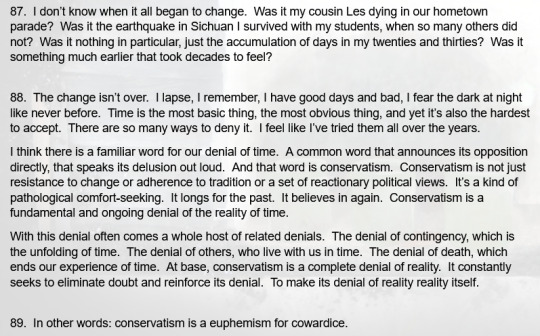

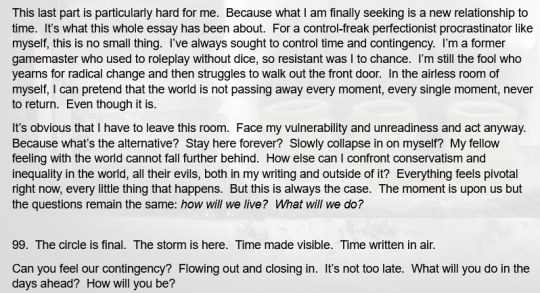
this is from a fucking essay about fortnite of all things but idk bro it hits what can i say
4 notes
·
View notes
Text
And mystery is not excellent.
Mystery lingers. It sticks, resonates. Sometimes I only recognize it much later. That game of the year has deadened in the mind. Its scripted glory did not last. While another game, flawed and cranky, keeps buzzing in my head, all gadflylike. It won’t let me go.
14 notes
·
View notes
Text
so take when tevis thompson said "I’m surviving, I’m surviving, I say, or think. I’m afraid I’ll still be here, in this room, when I wake up again" and heather havrilesky said "The cage is open. You can walk out anytime you want. Why are you still in there?" and sylvia plath said "It isn’t your room that’s a prison, it’s yourself" and that's essentially my conclusion chapter
4 notes
·
View notes
Text
What makes a game a good game? I’ve been thinking about this, as well as what I have to offer to the greater conversations that are perpetually in motion Online. Taking a break from my usual outlet due to a huge feeling of apathy, I looked back towards my younger days just posting whatever it was on my mind on Tumblr and thought that was a time I was more satisfied. Not with a byline or great recognition but just kinda creating and putting it out there for nobody but myself to look over on a portfolio. So here are some thoughts on game criticism and media and the way they are used and could be used.
There is no such thing as an objective review. A great example of this is Objective Game Reviews that would post “Game reviews that are fact, not opinion.” An example from their “review” of RAGE:
One of the weapons in RAGE is the “wingstick,” a thrown blade weapon that can slice off the limbs of enemies and return to the player. Wingsticks can be steered through the air by moving the crosshair, and if they hit a hard surface or an armored enemy they can break. The player can craft wingsticks and alternative ammunition with parts looted from the world or purchased from vendors. Normal ammunition can be looted from enemies and refilled during a fight, whereas if alternative ammunition runs out the player must pause to craft more.
Another great example is Jim Sterling’s “review” of Final Fantasy XIII. Sterling did not like Final Fantasy XIII, giving it a Below Average, 4/10, for Destructoid on March 16, 2010. Of course reactions ranged from “whoa!” to “you didn’t even play the game.” In response, Sterling wrote up an objective review:
The videogame has graphics and sound. The graphics are seen with your eyes and the sound is heard by your ears. When you start the game the graphics and the sound will occur almost at the same time, letting you know that the game has started. There is also text which players can read.
Gamers who cry out against reviews that are not objective just disagree with what is being said, and don’t actually want an objective review that is just listing the things in the game as factual statements with no opinion on whether those things are good or bad. The same can be said of those who cry that a reviewer is “biased” towards a certain game/company/genre/etc. Most famously this is hurled towards Nintendo reviews for games that are perceived as bad but get good reviews “because Nintendo.” Sometimes it can be hard to not fall into this trap, as my reaction towards Skyward Sword getting hugely praised in 2011 was viewed as coming from people who couldn’t help but worship at the feet of Zelda and Nintendo.
The issue though, of universal praise for nearly every major title every year is something worth discussing. Both Nick Capozzoli, Vincent Kinian, and Tevis Thompson have talked about this before, the latter with a bit more hostility and other issues all his own, but the fact remains that there is a deep hole of variety when it comes to game reviews. This isn’t helped by the fact that more sites are beginning to realize the stupidity of assigning a score to a game, as if a number can accurately sum up a game’s worth and that elevating all games on the scale of numerical weight means games never meant to be compared to each other will be. See the meme of IGN’s review of Party Babyz Wii whose 7.5 was copy+pasted next to “better” games that got a lower review score for years.
Tevis links back the inability for game critics to come out and say Red Dead Redemption 2 sucks to the universally praised Bioshock Infinite of 2013, a game that mainstream media made multiple offerings to in the form of breathless praise, whereas others wrote out their criticisms on the periphery, best exemplified by the recent Critical Compilation on the game.
One critic he mentions is Videogamedunkey, a YouTuber who puts out short videos about whatever game is currently in the discourse. His slant is generally as an entertainment, comedian, wanting to make his viewers laugh, but also he talks about what he liked in the game and what he didn’t like. With Red Dead Redemption 2 Dunkey’s conclusion is the excess bears down on the game and he became as disillusioned as protagonist Arthur Morgan does with his mentor Dutch. It’s a fine video/review, though doesn’t nearly have the bite Tevis appears to want with regards to Red Dead Redemption 2, a bite I personally found in Jess Joho’s review of the game for Mashable which most aligned with my own feelings on the game and one he does list. Listing Dunkey also either shows Tevis’ ignorance or agreement with another Dunkey video: Game Critics, which provoked lots of conversations about people who review games for larger sites. Though, reading through Tevis’ piece, that video might be why he apparently looks up to Dunkey for good criticism. It is not like some of the issues Dunkey lists are wrong.
You’ve got your fanboys, your hobbyists, your escapists. Your ‘objective’ reviewers, your consumer advisers, your spec hounds. Your people pleasers, your twitter cheerleaders, your industry bootlickers. Your never hate a game philosophers, your games are hard to make sympathizers, your but some people like it! tsk-tskers. You’ve got old critics who’ve given up and young critics who’re getting there. You’ve got so many internet professionals and professional apologists. The tired, the self-censored, the players of the game. None mutually exclusive. All guardians of the status quo.
I think the real issue here is that the required work to put into really proving this sort of thing is massive. Reading and sorting the reviews based on site and author, taking into account Twitter posts that extend the conversation into an endless timeline unsearchable by keyword due to the often vague nature of criticizing criticism publicly. There have probably been hundreds of tweets in response to just Tevis’ blog as well as games criticism in general. It seems like the conversation about reviewers, their role, their work, their compensation, their method, is repeated ad nauseum monthly. Games media loves to talk about games media. I mean here I am, someone much lower than those I’ve mentioned, talking about it myself.
This sort of work loses the point, about what is it that makes a game good? Objective reviews are useless, subjective reviews are useful. What makes a subjective opinion worth reading? What makes the work their talking about worth something? These are the sorts of things that have many answers.
Some small things to get out of the way are some more useless things, specifically the belief that a 10/10 means a game is perfect, is a belief that is hard to get around despite how simple it is. A 10/10 just means it is the pinnacle of what games can achieve and others should be more like this one. What constitutes a 10/10 is, as everything is, up to personal taste. For myself, 10/10’s practically don’t exist since no piece of art is without flaw. We are all humans. Remember before when I said assigning numerical value is stupid? Well given the circumstances of Metacritic, assigning a numerical score might not actually be a dumb thing when it's used as a statement, a punctuation at the end of your text. If Tevis used numerical scores in his reviews and got onto Metacritic he would be able to wield them much more usefully as a way to vocalize dissent through metascore than as just a page of text most will pass by without reading.
Phrases such as “Isn’t for everyone” or “not a perfect [x].” are also useless in terms of criticism. Not every game is made for everyone or could even accomplish that if it were the intention. That phrase can be applied to any and every game and is therefore useless. As mentioned before, no piece of art is perfect, so simply stating that as some sort of qualifier that, “I like this but it’s far from perfect,” is such a pathetic qualifier that should never be used.
A review worth reading is one that brings a point, a perspective, an idea that you didn’t have before about a piece of art and put it in your head. It also has to have supporting evidence for its conclusions, the sort of Philosophy 102 cogent argumentative qualities that blew my mind as a college kid. Given that we have already had decades of consumer grade reviews: ones that break a game into categories and tie them together into a qualitative statement at the end, that we would be able to move on from that into something different. This includes the derogatorily described “blog” reviews, ones that are less about whether or not the graphics never stuttered and more about whether or not a personal connection was made to a specific aspect of a game, whether large or incidental. These are the kind of conversations that bring something new than whether or not the guns sounded satisfactory. This is the sort of conversation that differentiates critical YouTubers like Raycevick from Noah Caldwell-Gervais. Both put out videos on the recent Wolfenstein series and both took very different approaches to what they wanted to say about the game. Raycevick was more focused on the mechanics, the variation of the map, the way it linked together its setpieces. Noah was more interested in what the game had to say about America, Nazism, and the ways to resist and cope with a fallen country. The former might make for a good quick recap of what the games are and what they do in a input-output sense (think right-trigger, left-trigger of Call of Duty), but it's the latter that does the digging into what the game is beyond whether the shooting was good or the stealth sections not too frustrating.
When ascertaining whether or not a game is good there are some easy questions to ask. Did I make an emotional connection? Was that emotional connection cheap (say showing a dog dying) or earned? Does the game have something to say about a topic and do I agree with or disagree with its conclusion about said topic? Did I enjoy spending time within the game and why? Was this a worthwhile spending of my time?
Mechanic’s based criticism is also valid, but personally less interesting. Does it matter if Anthem has good shooting and flying if the things surrounding it are bland? This is where subjectivity again comes in. So far, out of all the shlooters released, I’ve found that you can have the most mechanically satisfying circle, but if that is surrounded by mediocrity it doesn’t matter, it’s a bad game. I don’t care whether or not the shooting felt good in a game, I want to know if the things surrounding those mechanics is worth investing time into. Red Dead Redemption 2 had a rote shooting gallery mechanic underlying most all of its missions, and that couldn’t be saved by the characters and world surrounding it which left me feeling like I had wasted my time come the credits. Of course many felt the opposite, and its the ways we craft the arguments and explanations for why we felt that way that make a good criticism. A review is likely not going to and not meant to convince you that a game you hate is good, but it should at least allow you to understand why the author felt that way about it.
Something that has cropped up recently when covering games is the conditions under which they are made. As we, hopefully, work our way towards a labor revolution not only in games but across all aspects of culture, we have become more aware of the way corporations exploit the lower class workforce. AAA development means overwork, let’s not even get started on the lie of the 40 hour workweek, underpaid, and stress that routinely leads to the end of careers. Rockstar management came out and boasted about their 100 hour work weeks in New York Magazine, which was then qualified as just the writing team, and then was further qualified by a Kotaku report (that has been the norm) about the conditions under which Red Dead Redemption 2 was created. The question became whether or not this would affect reception of the game. It didn’t.
I sometimes struggled to enjoy Red Dead Redemption 2’s most impressive elements because I knew how challenging—and damaging—some of them must have been to make. Yet just as often, I found myself appreciating those things even more, knowing that so many talented people had poured their lives into crafting something this incredible.
The game currently has a 97 on Metacritic, there was only one “mixed” scored review, and even those who didn’t give scores offered only a slight hand wringing at the way the game was created in their text. Kotaku’s section ends with a shrug, “yeah the people who made this were exploited but I’ll be damned if that exploited work isn’t impressive.” It’s useless to have in the text as it leads nowhere, and the question of, “was their labor worth it?” should always be answered with a resounding NO. We are attempting to unionize the industry in order to keep exploitation from happening. What a fucking useless gesture to contemplate whether or not someone spending weeks crunching was “worth it.” It’s the sort of thing Tevis called out in his post,
They couch any troublesome truths in acceptable gamerese, outline all possible caveats, neuter any rhetorical force, maybe dress it up for their academic buddies while they’re at it. Suddenly everything is ‘messy’ or ‘complicated’ or ‘full of fascinating contradictions’. Sure, they’re ‘frustrated’, even ‘disappointed’, but they’re still rooting for the game. And always with due deference to their audience. It’s not for me but it’s cool if you and it’s totally just a taste thing now don’t get me wrong now I know what you’re thinking now I’m not saying that, y’all.
Some of this comes from the fact that games media is largely made up of, and rooted in, enthusiasts: people who do it out of a love for the media itself. This may best be exemplified by a recent (now deleted) tweet from Brian Altano, video host/producer at IGN Entertainment:
I've been working in the video game industry since 2007 and I don't think I've ever heard more than three people legitimately call themselves "game journalists" without being sarcastic, ironic, or putting it in air quotes while laughing about it. That's... not an actual thing.
Brian has never been someone you go to for criticism or news, the things journalists do. He exists to make you laugh, to entertain you. Going to Brian to determine whether or not you should buy a game will end with “Yes!” or “Maybe try it out.” Brian exemplifies the type of critic Tevis decries in his opening paragraph. He isn’t a critic, but he does represent a larger audience than critics do. There isn’t a real large audience for the type of work done at Bullet Points Monthly, or else their Patreon would be much higher than it currently is. People go to websites like IGN and GameSpot to have their already convinced minds reinforced that what they like is Important. This is why there are multiple articles whenever a new trailer or piece of information comes out about the next Star Wars or Marvel movie or Game of Thrones. These things are big so we have to talk about them and reinforce their importance, further enriching the pockets of corps like Disney, whose billion dollar company is immoral with its continued existence.
The roots of game criticism comes from the game magazines and websites of the 1990’s. Work that existed to be read and shared not because they did a good job interrogating the things they proclaimed to love but because they were entertaining to read and reinforced your love, whether it be Nintendo, Sega, Sony, or Microsoft. The same sort of circular reinforcement continues in the larger sites today, which is why AAA games will never fall below a favorable average on numerical compilation sites, with exceptions of course. Not that this sort of status quo is unique to just games media. Noam Chomsky, in the book On Western Terrorism, mentions how the media in the West give no time to dissenting opinion,
If you want to say that China is a totalitarian state you can say it, you know. If you want to say something like the U.S. is the biggest terrorist state in the world, they are not going to stop you, but you do sound like you are from Neptune, because you are not given the next five minutes to explain it. So you have two choices, to either repeat propaganda, repeat standard doctrine, or sound like you are a lunatic.
I hope you’ll forgive me for likening the universal love of game critics to the propaganda machine of western news media, as it's comically different in terms of importance, but the similarity is there. People who don’t conform to the generally accepted opinion on a game are labeled contrarians just looking to make a buck off a different opinion. Those who are praising Breath of the Wild are just Nintendo hacks. Those who call into question aspects of God of War are just SJW cucks.
Michael Thomsen touches on this status quo as well in his review of Jason Schreier’s book Blood, Sweat, and Pixels for The New Inquiry,
In these times, the most important task of game journalism isn’t to serve a public interest but to ensure that fans can continue to identify some version of themselves in the games they have played, and ensure future releases will allow them access to even deeper levels of self-expression and understanding. In playing the next game, owning the newest console, having an opinion on the latest patch, we feel like we can become stabler versions of ourselves, all at the cost of clearing out space—both mental and financial—for open-ended consumption of a form without any purpose beyond this increasingly tautological pleasure. This process is necessarily dehumanizing. Games matter because you are here to play them, and you remain here to play them because they matter.
We can do better, as being human is to strive to be more than we are (yeah its a corny Star Trek clip but that episode fucks me up). I think it should be obvious that better games criticism is probably pretty low in terms of importance when you look at other things, but I do think it has influence on creating and leading conversations, the kind that lead towards stronger rights for laborers and are more critical of the output of corporations who seek only to deepen their own pockets.
0 notes
Text
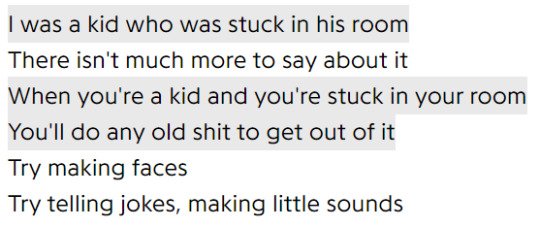


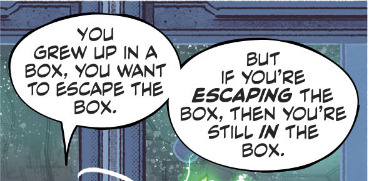
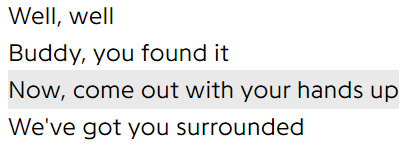


inside, bo burnham (2021) / it's not coming back, tevis thompson (2020) / mister miracle, tom king (2017)
#intertextuality#web weaving#bo burnham#netflix inside#quotes#mine#is this anything? is this something
25 notes
·
View notes
Text
Yet Another List of Video Essays
Annihilation and Decoding Metaphor - Folding Ideas
About the film Annihilation, how to find meaning in subtext-heavy film, and bad-faith movie criticism.
The Psychological Horror of Gaslighting, Explained - cherry bepsi
Looks at the films Gaslight and The Invisible Man (2020), as well as the manga story The Town Without Streets by Junji Ito.
The Systemic Abuse of Celebrities - Broey Deschanel
An exploration of celebrity culture and how damaging it is.
Elevated Horror & The Purpose of a Genre - Pim Is Online
Talks about the trend of 'elevated' horror films.
Who Shot Guybrush Threepwood? | Genre and the Adventure Game - Innuendo Studios
About adventure games, game genres, and genres as a whole.
Fortnite: The Party That's a Platform - Errant Signal
An exploration of the good and and the bad of Fortnite, with reference to Dan Olson's video and Tevis Thompson's article on the game.
Remembering With A Twist - A Jojo Rabbit & The Book Thief Video Essay - LadyKnightTheBrave
A deep dive into novel The Book Thief and Jojo Rabbit and how they portray Nazi Germany and Jewish characters.
Why the Music in Cats (2019) is Worse than you Thought - Sideways
An exploration into why the music in the Cats film is as bad as it is. (Note: the video got copyright-claimed, so parts of the video either have replaced music or are muted for a few seconds.)
A Thousand Ways of Seeing a Forest - Jacob Geller
The art of translation.
43 notes
·
View notes
Text
The Good Game Critics TM (a giant post o’ links)
yesterday i was complaining:
damn, how come the only people who are writing The Good Video Game Criticism TM are exclusively relegated to… abandoned Blogspots and Tumblrs that haven’t been updated in five years…?
and someone asked:
addadashofpepper: can you like, post links to some of these? cause the thing about these is that they are really hard to find!
oh boy, tumblr user @addadashofpepper, i would be DELIGHTED to share. i dug through my RSS reader / bookmarks, and here’s what leapt out at me:
[under a cut because this got LONG and i got EXCITED]
ella guro: indie dev and creator of Problem Attic, which made a splash back in the day (a somewhat Braid-inspired platformer iirc). she’s mostly removed herself from the game scene these days, but she still blogs about artsy-culture issues from time to time, and if you dig through the archives, some of her old posts on games (probably circa 2012-2015?) are so so good
prophet goddess / blood church: i discovered them literally two days ago, but i’m digging what i see (their ladykiller in a bind review was the first post i stumbled on)
dead genre chronicles: a group of three friends did a monthly JRPG podcast, where they’d play a JRPG in its entirety and talk about it. see, they found mainstream discussions around JRPGs annoyingly stilted, including the term JRPG itself—like, we’re still using the term “JRPG” to mean “turn-based combat with funky anime aesthetics,” but that airbrushes over so many weird and fun and distinctive mechanics that developers inside-and-outside of Japan have been experimenting with, right?
they had a blog attached to the podcast, and the blog was ALSO excellent
unfortunately, they took their main website down a while back :( however:
you can get some of the old blog posts by fiddling with the wayback machine
becky backed up a bunch of her contributions to the site (i particularly liked her ffxv post & this sort-of ffxiii post that punched me in the face in a good way)
leeroy, one of the other contributors, blags here, though i don’t think he backed up his stuff from the original site
the entirety of the podcast is archived on libsyn and is very good if you’re into podcasts!
no don’t die: okay, this blog/interview series is AMAZING. and still active!!! ahh!!!
the whole concept is, this dude finds people who work in games. or used to work in games. or who ran a weird fansite for video games back in the early 00′s. or curate some video-game-shaped things as part of a museum exhibit. and so on, and so forth.
the dude has a knack for finding really interesting people with all kinds of windows/perspectives on games, and manages to get them to talk about really interesting things. two of my fave interviews: rebecca heinman, who ported Doom to 3DO in ten weeks on her own in utterly batshit conditions, and mustin, because i’ve got that overclocked remix nostalgia
my friend pokey: so, they’re on tumblr, they write in all lowercase, and their writing style tends to be on the dense and referential side, which ordinarily has all the warning signs of “all pretentiousness, no substance,” right? (i am not exempt from this, by the way; look at me typing in all lowercase like a scrub.) but, i’ve reliably gotten interesting insights out of their posts & have been surprised how often i mention their blog to a Friend Whose Aesthetic Tastes I Respect and they’re like “ah! i LOVE that blog!” also i liked their notes on chrono cross at the end of this post because i literally want to talk about chrono cross every waking moment of my life, come talk to me about chrono cross friends, etc
em reed’s blog is excellent. i really liked this post about what the phone/gacha game experience is like
auntie pixelante: anna anthropy’s old blog; still not sure why she didn’t archive it somewhere? but whatever, the wayback machine has your back. this early review of Gone Home is reasonably representative
tim rogers: i have kind of mixed opinions on him, but i do find something in his work compelling enough that i keep coming back to him, so.
the dude made his initial splash with his extremely long mgs2 review back in the day; there’s a slightly more recent archive too; he also does a lot of sadposting on medium that ranges from “guy in my MFA” to “fuck i can’t believe this dude’s making me feel feelings” in quality, ymmv. (he also apparently does video reviews now? that are like many hours long? and i am just not the youtube generation so i tapped out on that one bud)
tevis thompson: another critic i have mixed feelings about, but if you’re the kind of dork that enjoys reading stuff that Made A Splash At The Time, and like, nerd subculture histories, you'll have to read his “on videogame reviews” for that reason alone. i also really dug his 100-word video game reviews series
ludus novus: i haven’t read this dude’s blog in ages, but i liked it a lot when i read it in 2012ish and there’s TONS in the archives
emily short: an IF writer who goes way back. i haven’t read her blog lately, but the archives / older posts definiely have cool thoughts on the structure of interactive fiction
jonas kyratzes: indie game dev, creator of The Sea Will Claim Everything. he tends to blog about lefty politics and general arts stuff more frequently than he blogs about games, but he does blog games from time to time. i liked [1] and [2], for starters.
adam cadre: this guy goes waaay back in the IF scene and has made a bunch of Inform stuff. i’ve never actually played his games! but i like his blog a lot (convenient tumblr mirror here). he almost exclusively blags about books and movies and such these days, but if you dig you can find him talking about games sometimes. (also, Masterchef Australia, which he loved so much he wrote over fifteen thousand words about it and it’s one of my favorite bizarre blog posts on the internet)
the fool reversed: this blog is focused on LARP game design & issues around that, but i’d say it’s relevant to anyone interested in game-y topics. as a mostly-outsider to that scene, i thought this was a fun find!
annnd a few last ones:
i haven’t kept up with critical distance in ages, but it used to be a great way to find new game writers, and quite possibly still is, i dunno
while i’ve personally bounced off timber owls a few times, i know some folks who like their writing a lot
hope this helps!!! happy digging through internet archives and such
13 notes
·
View notes
Link
My first graphic novel Second Quest is 40% off (just $9) from Fangamer and barring some miracle this might be your last chance to get a copy! That’s right, Fangamer is the primary distributor and they are clearing out their stock.
I’m so proud of this book, written by Tevis Thompson and drawn by me, it’s the story of a young girl questioning the xenophobic orthodoxy of her insular culture. It’s filled with references to The Legend of Zelda, expressing our desire for adventure. For free-thinkers and iconoclasts young and old.
Buy Second Quest from Fangamer now, while you still can! And if you have read it, please leave a short review and 5-star rating. Thank you ~
1 note
·
View note
Text
Reading 2020
6-January-2020: Beaumont, Matthew, Nightwalking: A Nocturnal History of London (2015, England)
9-January-2020: Otsuka, Julie, When the Emperor was Divine (2002, USA)
12-January-2020: Lehmann, John, In a Purely Pagan Sense (1976, England)
12-January-2020: Modiano, Patrick, Little Jewel (2001, France)
19-January-2020: Dickens, Charles, Hard Times (1854, England)
20-January-2020: Didion, Joan, The Year of Magical Thinking (2005, USA)
28-January-2020: Hunt, Laird, In the House in the Dark of the Woods (2018, USA)
2-February-2020: Hardy, Thomas, Under the Greenwood Tree (1872, England)
5-February-2020: Lehman, David, One Hundred Autobiographies: A Memoir (2019, USA)
15-February-2020: Oshinsky, David M., “Worse Than Slavery”: Parchman Farm and the Ordeal of Jim Crow (1996, USA)
17-February-2020: Zola, Émile, His Excellency Eugène Rougon (1876, France)
22-February-2020: King, Dean, Skeletons on the Zahara: A True Story of Survival (2004, USA)
29-February-2020: Graves, Robert, They Hanged My Saintly Billy (1957, England)
8-March-2020: Wyndham, John, The Day of the Triffids (1951, England)
14-March-2020: Ginsberg, Allen, South American Journals (1960, USA)
29-March-2020: Mantel, Hilary, Wolf Hall (2009, England)
5-April-2020: Butler, Octavia, Parable of the Sower (1993, USA)
12-April-2020: Butler, Octavia, Parable of the Talents (1998, USA)
15-April-2020: O’Brien, Glenn (ed), The Cool School: Writing from America’s Hip Underground (2013, USA)
16-April-2020: Moravia, Alberto, Agostino (1943, Italy)
19-April-2020: Ross, Lillian, Picture (1952, USA)
25-April-2020: Carson, Rachel, Silent Spring (1962, USA)
3-May-2020: Mantel, Hilary, Bring Up the Bodies (2012, England)
6-May-2020: Duras, Marguerite, The Lover (1984, France)
10-May-2020: Ma, Ling, Severance (2018, USA)
14-May-2020: Hale, Grace Elizabeth, Cool Town: How Athens, Georgia Launched Alternative Music and Changed American Culture (2020, USA)
17-May-2020: Kadare, Ismael, The Traitor’s Niche (1978, Albania)
20-May-2020: Saikaku, Ihara, Comrade Loves of the Samurai (Anthology) (1687, Japan)
14-June-2020: Mantel, Hilary, The Mirror and the Light (2020, England)
20-June-2020: Ballard, J. G., The Kindness of Women (1991, England)
25-June-2020: Orikuchi, Shinobu, The Book of the Dead (1943, Japan)
27–June-2020: Jefferson, Margot, Negroland: A Memoir (2015, USA)
30-June-2020: Douglass, Frederick, Narrative of the Life of Frederick Douglass, An American Slave (1845, USA)
5-July-2020: Ellison, Ralph, Invisible Man (1952, USA)
6-July-2020: LeCarré, John, Call for the Dead (1961, England)
11-July-2020: LeCarré, John, A Murder of Quality (1962, England)
14-July-2020: LeCarré, John, The Spy Who Came in from the Cold (1963, England)
18-July-2020: LeCarré, John, The Looking Glass War (1965, England)
24-July-2020: LeCarré, John, Tinker, Tailor, Soldier, Spy (1974, England)
1-August-2020: LeCarré, John, The Honourable Schoolboy (1977, England)
7-August-2020: LeCarré, John, Smiley’s People (1979, England)
10-August-2020: Pendarvis, Jack, Cigarette Lighter (Object Lessons) (2016, USA)
14-August-2020: Greenwell, Garth, Cleanness (2020, USA)
29-August-2020: Perlstein, Rick, Reaganland: America’s Right Turn, 1976-1980 (2020, USA)
4-September-2020: Burnside, John, A Lie About My Father (2006, Scotland)
6-September-2020: Massini, Stefano, The Lehman Trilogy (2016, Italy)
7-September-2020: Tevis, Walter, The Man Who Fell to Earth (1963, USA)
9-September-2020: Thompson, Kara, Blanket (Object Lessons) (2019, USA)
11-September-2020: Howard, Jennifer, Clutter: An Untidy History (2020, USA)
15-September-2020: Tuan, Yi-Fu, Landscapes of Fear (1979, USA)
29-September-2020: Balzac, Honore, Lost Illusions (1843, France) (reread)
7-October-2020: Bowen, Elizabeth, Eva Trout (1969, Ireland)
14-October-2020: Gary, Romain, The Company of Men (1949, France)
24-October-2020: Brontë, Charlotte, Villette (1853, England)
24-October-2020: De Lillo, Don, The Silence (2020, USA)
30-October-2020: Krúdy, Gyula, The Adventures of Sindbad (1917, Hungary)
3-November-2020: Kehlmann, Daniel, Tyll (2017, Germany)
8-November-2020: Undset, Sigrid, Olav Audunssøn, Vol 1: Vows (1925, Norway)
15-November-2020: Pullman, Philip, The Secret Commonwealth (2019, England)
23-November-2020: Baker, Nicholson, Baseless: My Search for Secrets in the Ruins of the Freedom of Information Act (2020, USA)
27-November-2020: Kempowski, Walter, All for Nothing (2006, Germany)
29-November-2020: Ainsworth, William Harrison, Auriol (1844, England)
29-November-2020: Modiano, Patrick, Pedigree (2005, France)
1-December-2020: Liming, Sheila, Office (Object Lessons) (2020, USA)
13-December-2020: Baker, J.A., The Peregrine (1967, England)
18-December-2020: Allain, Marcel and Pierre Souvestre, Fantômas (1911, France)
23-December 2020: Szerb, Antal, The Queen’s Necklace (1942, Hungary)
23-December-2020: Leys, Simon, The Death of Napoleon (1986, Australia)
25-December-2020: MacLeod, Alistair, No Great Mischeif (2000, Canada)
27-December-2020: Chateaubriand, François-Rene, Memoirs from Beyond the Grave (1846, France)
29-December-2020: Anonymous, The Life of Lazarillo de Tormes: His Fortunes and Adversities (1554, Spain)
30-December-2020: Stifter, Adalbert, Rock Crystal (1846, Austria)
1 note
·
View note
Link
It’s a con, all of it. The staged world, the stock characters, the hollow story, the “good man” Arthur, the wretched missions, the stupid shooting galleries, the sulky masculinity, the blinkered whiteness, every masturbatory detail. The game believes in nothing, cares about nothing but its own con.
And we want to be conned. We want it. We love the lies. We love the con of videogames.
Videogame culture is humiliating.
It’s not every year that a game so hyped, so lionized, so slathered with superlatives is so plainly godawful. Stupid games like Far Cry 5 are near annual occurrences, but a game as bad as Red Dead Redemption 2 only comes along every generation or so. It takes a certain budget and a particular talent for self-delusion to really pull it off. Because if there’s one thing worse than a stupid game that revels in its stupidity, it’s a stupid game that doesn’t know it’s stupid. That instead imagines itself as something greater, something serious, even magisterial, something like Art. A game that cons not only players and critics but, finally, itself.
I can’t pretend to have any sympathy for it. I’m exhausted by cons, given our current reality. And in the end, cons are very hard to fight. They aren’t just singular lies. They are plural lies, contagious lies, deeply social lies. A con is a lie that requires widespread belief and complicity to work. It’s a mutual lie that depends, absolutely, on the faithful, on willing marks, their participation and investment. When most effective, a con is a generative lie, a lie that produces other lies. A lie that creates more liars. It’s a lie you desperately want to be true, so much so that it undermines the very possibility of truth. Because a con is fundamentally a lie about the world, and about the reality of yourself in it. It is, at heart, a metaphysical lie.
You can criticize a con all you want and still never get at the frame, the assumptions, the motivations that keep it going. Especially if the con is big enough, expensive enough, and ever so attended to by a complicit media. So instead of detailing every single lie in Red Dead Redemption 2, I want to ask a few questions:
Why do you find this world convincing? Why do you think this story and these characters are good? How can you stomach the mournful tone? How can you play these missions without wanting to claw your eyes out?
Though there is really only one question in the end: why do you love the con of videogames?
Maybe you don’t think videogames writ large are a con. Maybe you don’t think Red Dead Redemption 2 in particular is either. So what do you call something that looks this good and plays this bad? That details this much and means this little? That’s this technically impressive and also this anachronistic? That centers shitty white men and says this is just the way it is? That has you murder thousands and yet declares you’re still a good man?
Is this not videogames? Is this not a con?
26 notes
·
View notes
Text
Tevis Thompson interview about turning video games criticism into subtext for SECOND QUEST

Several years ago, popular video game critic Tevis Thompson created a wonderful graphic novel called Second Quest, a Zelda-like fantasy story that addresses a lot of his feelings about the franchise. I had a wonderful discussion with him about how he did that and his creative process.
Matt Chats: Tevis Thompson rethinks Zelda in SECOND QUEST
0 notes
Photo

The Groundwork
On the heels of the chaos of late 2001, Kadlec’s vision for U.S. biodefense policy was rapidly coming to fruition before his very eyes. The first enabling statute for the SNS was the Public Health Security and Bioterrorism Preparedness Act of 2002, largely motivated by the anthrax attacks, which directed the Secretary of HHS to maintain a “Strategic National Stockpile (SNS).” The legislation had been the direct result of a process begun years earlier when Congress earmarked funding for the CDC to stockpile pharmaceuticals in 1998. The program was originally called the National Pharmaceutical Stockpile (NPS) program.
Kadlec’s role in directing subsequent developments in the SNS and other related legislative developments was considerable given that, in 2002, he became director for biodefense on the recently created Homeland Security Council. His work on the council, which he left in 2005, resulted in the Bush administration’s “National Biodefense Policy for the 21st Century,” which unsurprisingly echoed the recommendations of the paper Kadlec had sponsored at the National War College.
On March 1, 2003, the NPS became the Strategic National Stockpile program and was managed jointly by DHS and HHS after George W. Bush issued Homeland Security Presidential Directive (HSPD-5). Two days before, Secretary of Homeland Security, Tom Ridge and then Secretary of HHS Tommy Thompson had presented the Project BioShield Act to Congress. It was a sweeping piece of legislation that established what would become a government money teller-window for Big Pharma, called the Biomedical Advanced Research and Development Authority (BARDA), among other entities and powers, not least of which was moving control of the SNS away from DHS and closer to HHS.
Soon after BioShield was signed into law, BioPort/Emergent BioSolutions co-founded a lobby group called the Alliance for Biosecurity as part of its strategy to easily secure lucrative BioShield contracts. That lobby group saw Emergent BioSolutions join forces with the University of Pittsburgh’s Center for Biosecurity, which was then-led by Tara O’Toole and advised by Randall Larsen.
With this framework in place, the Kadlec-drafted National Biodefense Policy for the 21st Century was used as the framework for Bush’s Homeland Security Presidential Directive 10 (HSPD-10), which further expanded BioShield, the SNS and other controversial programs. Project BioShield was made law in 2004 and, one year later, Kadlec joined Senator Richard Burr’s subcommittee on bioterrorism and public health. There, Kadlec served as staff director on the committee that drafted the Pandemic and All-Hazards Preparedness Act (PAHPA), containing the specific policy directives for the roll out of Project BioShield and creating Kadlec’s future position at HHS.
PAHPA was passed the following year in the aftermath of Hurricane Katrina and established the statutory relationship between the various agencies enacted or included in the BioShield legislation. This includes delegating to the newly creation position of HHS Assistant Secretary for Preparedness and Response (ASPR) to “exercise the responsibilities and authorities of the Secretary [of HHS] with respect to the coordination of ”the stockpile and to oversee the advanced research and development of medical counter-measures funded by BARDA, but conducted by Big Pharma. ASPR was also given the leadership role in directing HHS’ response to a national health emergency.
Serving alongside Kadlec in the White House throughout this entire process was Tevi Troy, a Special Assistant to the President for Domestic Policy; a role which made him the White House’s lead adviser on health care, labor, education and other issues with a special focus on crisis management. Troy, who had come up through the department of labor as deputy assistant for policy was already a Senior fellow at both the Hudson Institute and its satellite think tank, the Potomac Institute for Policy Studies (PIPS), where the real policy development work was undertaken.
Both Troy and Kadlec would exit the administration at the end of Bush’s first term and not return until the latter half of his second term. In the meantime, the wheels had been set in motion with the passing of Project BioShield and PAHPA and, soon after their passage, panic over a “Bird flu” outbreak began, which had spread first in 33 cities in Vietnam and then led to an outbreak of the poultry-killing disease that affected all of Eurasia, Africa and the Middle East. The outbreak sparked panic in the U.S. in late 2005, thanks in large part to over-the-top warnings made by Tommy Thompson’s successor as head of HHS, Michael Leavitt.
Despite the fact that Leavitt’s claims were wildly inaccurate, some administration officials benefited financially from the fear-mongering, such as Donald Rumsfeld, whose stock holdings in the pharmaceutical company Gilead netted him $5 million once the scare had ended. Part of the reason for Gilead’s jump in profitability resulted from the decision of the Pentagon and other U.S. government agencies to stockpile 80 million doses of Tamiflu, a drug promoted to treat the Bird Flu that was originally developed by Gilead. Rumsfeld had been the top executive at Gilead before joining the George W. Bush administration. Aside from those who benefited monetarily, the Bird Flu scare also gave a considerable boost to the biodefense “stockpile” agenda that Kadlec and other insiders supported.
Kadlec would return to the White House as Special Assistant for Homeland Security and Senior Director for Biological Defense Policy in 2007 to further solidify his eventual grip on the Strategic National Stockpile and the office of ASPR, along with his Hudson Institute/PIPS sidekick, Tevi Troy, concurrently appointed Deputy Director of HHS. This put Troy in charge of implementing the very policies enshrined in PAHPA and the departmental changes enacted as part of Project BioShield.
The Bush administration came to its inevitable conclusion as Barack Obama was elected and sworn in, early 2009. Kadlec and Troy, once again, left their government posts and disappeared into their private sector lairs. But, that same year, the first practice run for Kadlec’s freshly retrofitted SNS took place when the “Swine Flu” (H1N1) pandemic triggered its “largest deployment” ever, distributing nearly 13 million antiviral regimens, as well as medical equipment and other drugs nationally and internationally in conjunction with BARDA. Gilead (and Rumsfeld) again profited handsomely, as did other large pharmaceutical companies, which were eager to restock the SNS after its large-scale deployment.
The virus’ origins have been a matter of controversy for several years, alternatively identified as having sprung from pigs in Mexico or Asia. One of the last studies conducted in 2016 claims to have definitively traced the source to hogs in Mexico. Regardless of its true origins, interested observers were able to glean vital data from the exercise to prepare for the “next one.”
READ MORE
https://www.thelastamericanvagabond.com/head-hydra-rise-robert-kadlec/
0 notes
Text
There’s a notable increase of Utah ties in the NFL this offseason
New Post has been published on https://tattlepress.com/nfl/theres-a-notable-increase-of-utah-ties-in-the-nfl-this-offseason/
There’s a notable increase of Utah ties in the NFL this offseason

Each summer over the past eight years, the Deseret News has created a master list of Utah ties in the NFL during the offseason. This year, there are 89 Utah ties on an NFL roster just a few weeks before teams head to training camps near the end of July.
How does the number of Utah ties on NFL rosters in 2021 stack up to past seasons?
The 89 Utah ties currently in the NFL is significantly higher than the past three seasons — there were 74 last season, 76 in 2019 and 79 in 2018.
The 2017 offseason set the standard in recent years, when there were 90 local players on NFL rosters around this time, paced by a strong contingent of 35 rookies. Earlier this offseason, there were 90 Utah ties on NFL rosters, before former South Sevier High’s Alani Pututau was released by Atlanta.
In 2016, there were 75 Utah ties on rosters during the summer, with 70 in 2015 and 66 in 2014.
This year’s crop of 89 local players includes 16 rookies, with eight draft picks and eight undrafted free agents.
Here’s a breakdown of those 89 players (note: they can count towards multiple categories):
29 who played at the University of Utah (down from 30 last year)
26 who played at BYU (up from 12 last year)
14 who played at Utah State (down from 15 last year)
4 who played at Weber State (equal to 4 last year)
4 who played at Snow College (equal to 4 last year)
1 who played at Southern Utah (down from 2 last year)
42 who played football at Utah high schools (up from 30 last year)
So, why is there such an increase of Utah ties this year?
Three main reasons contribute to the sizable jump of Utah ties in the NFL:
BYU went from 12 players in the NFL in the 2020 offseason to 26 this year. There are 13 Cougars who will be rookies in 2021 — if they make it to an opening day roster — headlined by quarterback Zach Wilson, the No. 2 overall selection by the New York Jets in the 2021 NFL draft.
The number of Utah high school players in the NFL saw an increase of 40% from last year to this year. In addition to Wilson, who went to Corner Canyon High, former Desert Hills High’s offensive tackle Penei Sewell was a first-round draft pick — he went No. 7 overall to the Detroit Lions — and there were seven total Utah high schoolers taken in this year’s draft. There are a total of 10 Utah high school rookies overall.
The University of Utah, yet again, leads the way among state representatives, and the number of Utes only went down one even though longtime quarterback Alex Smith retired and no Utah rookies were drafted — thanks in large part to COVID-19 impacting the past year. Even so, the Utes have had 21 players drafted in the past five years and 18 of them are still in the league.
Here’s a look at each Utah tie in the NFL, listed by team in alphabetical order:

San Francisco 49ers middle linebacker Fred Warner (54) in action against the Arizona Cardinals during an NFL football game, Saturday, Dec. 26, 2020, in Glendale, Ariz.
Jennifer Stewart, Associated Press
BYU players in the NFL
Name Pos. NFL Utah high school (if applicable)
Name Pos. NFL Utah high school (if applicable)
Zayne Anderson S Kansas City Chiefs Stansbury Matt Bushman TE Las Vegas Raiders N/A Brady Christensen OT Carolina Panthers Bountiful Michael Davis CB Los Angeles Chargers N/A Zac Dawe DE Atlanta Falcons Pleasant Grove Chandon Herring OL Tennessee Titans N/A Taysom Hill QB New Orleans Saints N/A Tristen Hoge OG New York Jets N/A Bronson Kaufusi TE Green Bay Packers Timpview Corbin Kaufusi OL San Francisco 49ers Timpview Isaiah Kaufusi LB Indianapolis Colts Brighton Dayan Lake CB Los Angeles Rams Northridge Harvey Langi LB New England Patriots Bingham Dax Milne WR Washington Football Team Bingham Kai Nacua S San Francisco 49ers N/A Micah Simon WR Carolina Panthers N/A Daniel Sorensen S Kansas City Chiefs N/A Sione Takitaki LB Cleveland Browns N/A Khyiris Tonga DT Chicago Bears Granger Kyle Van Noy LB New England Patriots N/A Fred Warner LB San Francisco 49ers N/A Troy Warner S Los Angeles Rams N/A Chris Wilcox CB Tampa Bay Buccaneers N/A Jamaal Williams RB Detroit Lions N/A Ty’Son Williams RB Baltimore Ravens N/A Zach Wilson QB New York Jets Corner Canyon

Denver Broncos offensive tackle Garett Bolles (72) warms up before an NFL football game against the Las Vegas Raiders, Sunday, Jan. 3, 2021, in Denver.
Jack Dempsey, Associated Press
Utah players in the NFL
Name Pos. NFL Utah high school (if applicable) Utah junior college (if applicable)
Name Pos. NFL Utah high school (if applicable) Utah junior college (if applicable)
Brian Allen CB Cleveland Browns N/A N/A Bradlee Anae DE Dallas Cowboys N/A N/A Cody Barton LB Seattle Seahawks Brighton N/A Jackson Barton OT New York Giants Brighton N/A Francis Bernard LB Dallas Cowboys Herriman N/A Julian Blackmon FS Indianapolis Colts Layton N/A Marquise Blair S Seattle Seahawks N/A N/A Garett Bolles OT Denver Broncos Westlake Snow Devontae Booker RB New York Giants N/A N/A Terrell Burgess S Los Angeles Rams N/A N/A Kylie Fitts OLB Arizona Cardinals N/A N/A Leki Fotu DT Arizona Cardinals Herriman N/A Matt Gay K Los Angeles Rams Orem N/A Javelin Guidry DB New York Jets N/A N/A Chase Hansen LB New Orleans Saints Lone Peak N/A Tyler Huntley QB Baltimore Ravens N/A N/A Jaylon Johnson CB Chicago Bears N/A N/A Star Lotulelei DT Buffalo Bills Bingham Snow Zack Moss RB Buffalo Bills N/A N/A Jared Norris LB Washington Football Team N/A N/A Tim Patrick WR Denver Broncos N/A N/A Darrin Paulo OL Detroit Lions N/A N/A John Penisini DL Detroit Lions West Jordan Snow Eric Rowe CB/S Miami Dolphins N/A N/A Pita Taumoepenu LB Denver Broncos Timpview N/A Sam Tevi OT Indianapolis Colts N/A N/A Hunter Thedford TE Detroit Lions N/A N/A Marcus Williams FS New Orleans Saints N/A N/A Mitch Wishnowsky P San Francisco 49ers N/A N/A

Seattle Seahawks middle linebacker Bobby Wagner stands on the field between drills during NFL football practice Tuesday, June 15, 2021, in Renton, Wash.
Ted S. Warren, Associated Press
Utah State players in the NFL
Name Pos. NFL Utah high school (if applicable)
Name Pos. NFL Utah high school (if applicable)
Jalen Davis CB Cincinnati Bengals N/A Dominik Eberle K Las Vegas Raiders N/A Kyler Fackrell LB Los Angeles Chargers N/A Tipa Galeai DE Green Bay Packers N/A Tyler Larsen C Washington Football Team Jordan Nevin Lawson CB Las Vegas Raiders N/A Dallin Leavitt S Las Vegas Raiders N/A Jordan Love QB Green Bay Packers N/A JoJo Natson WR/Ret. Cleveland Browns N/A Dax Raymond TE Pittsburgh Steelers Timpview Patrick Scales LS Chicago Bears Weber Darwin Thompson RB Kansas City Chiefs N/A Nick Vigil LB Minnesota Vikings Fremont Bobby Wagner MLB Seattle Seahawks N/A

Buffalo Bills cornerback Taron Johnson (24) runs back an interception for a touchdown during the second half of an NFL divisional round football game against the Baltimore Ravens Saturday, Jan. 16, 2021, in Orchard Park, N.Y.
John Munson, Associated Press
Other Utah college players in the NFL
Name Pos. NFL College Utah high school (if applicable)
Name Pos. NFL College Utah high school (if applicable)
Miles Killebrew S Pittsburgh Steelers Southern Utah N/A Taron Johnson CB Buffalo Bills Weber State N/A Sua Opeta OG Philadelphia Eagles Weber State Stansbury Andrew Vollert TE Indianapolis Colts Weber State N/A Jonah Williams DE Los Angeles Rams Weber State N/A

Detroit Lions offensive tackle Penei Sewell runs a drill during NFL football practice in Allen Park, Mich., Thursday, June 3, 2021.
Paul Sancya, Associated Press
Other Utah high school players in the NFL
Name Pos. NFL Utah high school Utah junior college (if applicabe)
Name Pos. NFL Utah high school Utah junior college (if applicabe)
Branden Bowen OT Arizona Cardinals Corner Canyon N/A Jordan Devey OL Buffalo Bills American Fork Snow Kaden Elliss LB New Orleans Saints Judge Memorial N/A Simi Fehoko WR Dallas Cowboys Brighton N/A Alohi Gilman S Los Angeles Chargers Orem N/A Porter Gustin DE Cleveland Browns Salem Hills N/A Andre James OT Las Vegas Raiders Herriman N/A Marcus Kemp WR Kansas City Chiefs Layton N/A Bryan Mone DT Seattle Seahawks Highland N/A Dalton Schultz TE Dallas Cowboys Bingham N/A Penei Sewell OT Detroit Lions Desert Hills N/A Xavier Su’a-Filo OT Cincinnati Bengals Timpview N/A Noah Togiai TE Indianapolis Colts Hunter N/A Jay Tufele DT Jacksonville Jaguars Bingham N/A John Ursua WR Seattle Seahawks Cedar/Westlake N/A
Source link
0 notes
Text
Alright, I’m going to ramble about it anyway, just look away (or indulge me, though I honestly don’t expect anyone to read this):
It’s been pointed out several times—both by myself and by others to me—, that I tend to write “around” or cut away from scenes of both graphic sex and graphic violence. I think of everything unsaid in “me and mr. wolf” and the comment on “call me by your printer” where the reader thought the story felt angsty despite the actual story being just a scene of consensual sex. I know people laugh when I bring that commenter up, but I take their thoughts seriously, because I definitely do think there’s a similarity between the techniques I used in “printer” to compensate for not being good at writing regular smut and how I have been trying to present trauma lately.
Whenever I think about “going cold” and the whole writing “around” thing, I think of this section from Will Harris’s “Withness vs Witness,”
In Scenes of Subjection: Terror, Slavery, and Self-Making in Nineteenth-Century America (Oxford University Press, 1997), Saidiya Hartman claims that there’s an “uncertain line between witness and spectator.” Accordingly, she refuses to reproduce the graphic account of Aunt Hester’s beating from the first chapter of Narrative of the Life of Frederick Douglass, first published in 1845. It’s too easy to put such horror into words and so think that you’ve faced up to it. Accounts of extreme hurt may prompt indignation, but Hartman argues that they eventually “immure us to pain by virtue of their familiarity.” That in some sense, to demand “suffering be materialized and evidenced” is more “obscene” than the original torture.
The refusal to type out an act of violence again—to re-witness it—points to a different subject-object relation. It acknowledges that the subject is implicated in what and how they see. And if we care about respecting the suffering of others this needs to be taken into account. Witness carries no moral imperative in itself; the act of seeing is not inherently virtuous.
This idea of “going cold” in writing, to let the audience witness and then fill the page with their own horror, is definitely a really great writing technique — but it has its drawbacks. I know I don’t usually quote my original stuff on here, and I know I’m not giving much context, but I think this still sums it up better than I could just vomiting my all thoughts back up as rhetoric:
[. . . ] as if you were too stupid to hear the rattle of your gun under the backseat, the nervous clicking of bullets huddled together in an old shoebox. You want to call him back over, beg as casually as possible to just relax with me a little longer. You wish you had your whiteboard to throw at him. You wish they hadn’t cut out your tongue. You—
—wonder how well we ever see each other, critic Tevis Thompson writes of his favorite golfing game and his grandfather’s death. I wonder how well we ever see ourselves. I worry that our love cannot find expression, that it cannot be spoken and truly shared.
I recited this quote in the only letter I got to write to my sister while she was [in inpatient treatment]. I was trying to explain how I could sob while writing something so terse and—
—dry everywhere but his eyes as he returns with two boxes. In his hands is your old shoebox, eroded by a dozen moves and five years of pet rats. On top of that is the heart defibrillator.
I also know I mentioned last year, when a piece of mine was nominated for Best of the Net, being honestly disgusted by it. This, this “coldness,” is precisely why. I honestly can’t put words how profoundly humiliating it is to realize that the only way to convey my trauma and pain to other people is by removing myself from it and turning it into spectacle, into this sad, washed-out tableau vivant.
I don’t want to focus too much on this, though—both because it’s upsetting to me and because I’ve already written about it several times now. Writing about trauma in a cool, detached tone is the soundcloud rap of literary non/fiction. We get it by now.
But another thing that complicates this idea of “coldness” is that it rests on the premise that you can trust your audience to understand that what they’re reading is fucked up. And for a lot of survivors and marginalized peoples, this is simply not the case. The “horror” reaction is deeply contextual. To return to Harris’s example of Hartman and Fredrick Douglas, while I totally understand and agree with Hartman’s decision not to reprint the whipping scene, in Douglas’s time, the misery of slaves was simply not taken seriously by mainstream culture. Letting the audience look away does not work when looking away is what they’re already used to doing.
In contrast to this, I think of all the discussions black critics have had of films like Antebellum or that Amazon US show wherein the suffering of black slaves and black Americans is portrayed in horrifying detail, 4K HD. We get it already, they say. “Did you know that white people ha—” Yes, yes we do.
Further, these films and shows rest in the tradition of portraying black pain as the only black story worth telling— I think of the authors who have spoken up about no longer being invited to panels or conventions after deciding to no longer talk about their race. About sitting in on a panel of black female romance authors and hearing them discuss the lack of representations of black joy. This is to say nothing of fantasy books that present their fantasy racism in graphic detail—trying not to offend by painting their (always side) characters of color green and pink, but still making the work uncomfortable for or even hostile towards real readers of color.
To move away from race, my presentation for disability class yesterday focused on the BBC mini-series Crip Tales; episode three, “Thunderbox,” focused on a wheelchair-user being coerced into having an abortion. We don’t see the abortion itself, as the actual episode is a monologue performed in an outhouse/confessional box, but the story still provides a great example of how the recognition of pain is not universal.
As she says,
I sat in the disappointment room. Last on the list. ‘It might get more complicated with you.’ I got a pat on the hand. They went in. They went out. A lady whispered: ‘You’re lucky, you know. No one’s going to judge you for getting rid.’ Got another pat. My turn, I went in, doctor said: ‘You’ve made the right choice.’ He…
She pats her own hand.
Now, I could easily write an entire essay about this one 15-minute monologue because I have so much to fucking say, but I just want to highlight that this was aired in 2020.
I realized this context issue while reading Mask’s “Biodiversity.” The narration of Alberto’s pain in that fic is absolutely NOT cold or minimalistic—it’s the exact opposite, completely unrestrained and unabashedly emotional, in such a way that makes it seem like Alberto is begging the reader to make this pain seriously. I’m glad people liked that story; it makes me jealous.
And none of this is to say that all of these examples are 1:1 comparable, because they aren’t, but I do think that asking these types of questions of my writing is really important. Yeah, yeah, fanfiction is still the orphan little sister of the arts, but it’s where I try shit out, you know? I can’t pretend there’s a distinction between my aesthetics in fanfic and in original writing when the only real difference is the dick-jokes-to-wordcount ratio.
8 notes
·
View notes
Text
THE DJINN (2021, IFC) Horror Movie Review - A Terrifying Tale of Terror
On episode 446 of Horror News Radio:
The Grue-Crew review… THE DJINN (2021, IFC).
Warning: possible spoilers after the initial impressions!
Be sure to subscribe to the Gruesome Magazine YouTube channel to catch all the HNR episodes.
This is HORROR NEWS RADIO, the official GRUESOME MAGAZINE podcast. Back with Doc Rotten once again are the scariest, goriest, bloodiest co-hosts on the 'Net.
Dave Dreher, the lead news writer at Gruesome Magazine.
Award-winning filmmaker Christopher G. Moore.
Podcasting Rock Star & International Cosplay Queen, Vanessa Thompson.
REVIEW: THE DJINN (2021, IFC)
A mute boy is trapped in his apartment with a sinister monster when he makes a wish to fulfill his heart's greatest desire.
IMDb.com
Available In Theaters, Digital, and VOD on May 14, 2021.
Directed by: David Charbonier, Justin Powell
Written by: David Charbonier, Justin Powell
Cast: Ezra Dewey, Rob Brownstein, Tevy Poe
ANNOUNCEMENT
Decades of Horror The Classic Era is partnering with THE CLASSIC SCI-FI MOVIE CHANNEL which will now include video episodes of The Classic Era!
Available on Roku, AppleTV, Amazon FireTV, AndroidTV, Online Website.
Across All OTT platforms, as well as mobile, tablet, and desktop.
https://classicscifichannel.com/
CONTACT
Patreon:
https://www.patreon.com/gruesomemagazine
Instagram:
https://www.instagram.com/gruesomemagazine/
Facebook Group:
https://www.facebook.com/groups/HorrorNewsRadioOfficial/
Events:
https://gruesomemagazine.com/events/list/
Vanessa, Facebook:
https://www.facebook.com/scarlettspitfire
Vanessa, Instagram:
https://www.instagram.com/scarlett_spitfire/
Christopher, Instagram:
https://www.instagram.com/ilikefilms/
Christopher, Facebook:
https://www.facebook.com/FilmmakerChristopherGMoore
Doc, Facebook:
https://www.facebook.com/DocRottenHNR
Dave, Facebook:
https://www.facebook.com/drehershouseofhorrors
Check out this episode!
0 notes
Photo
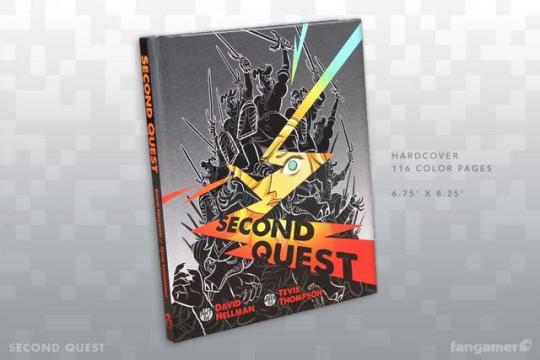



“Second Quest is a graphic novel about a girl who does not accept the world she lives in. It’s a meditation on videogame culture and its most beloved legends. It’s a story of the islands we inhabit and why we refuse to leave. It asks what it really means to have courage.”
Second Quest, the graphic novel from David Hellman and Tevis Thompson, is now just $15 in our books and zines section. Available at Fangamer.
16 notes
·
View notes